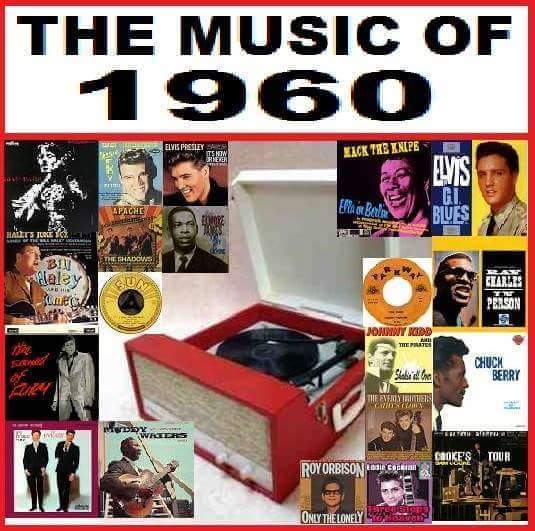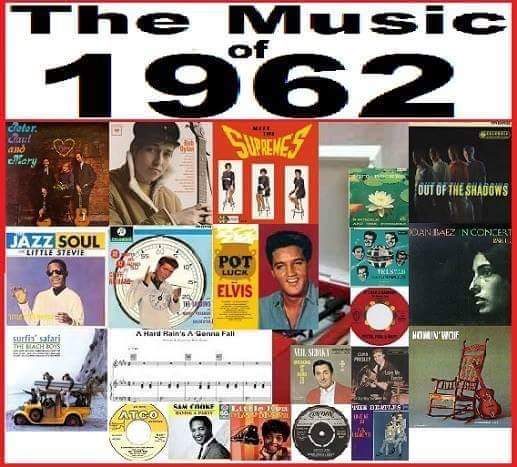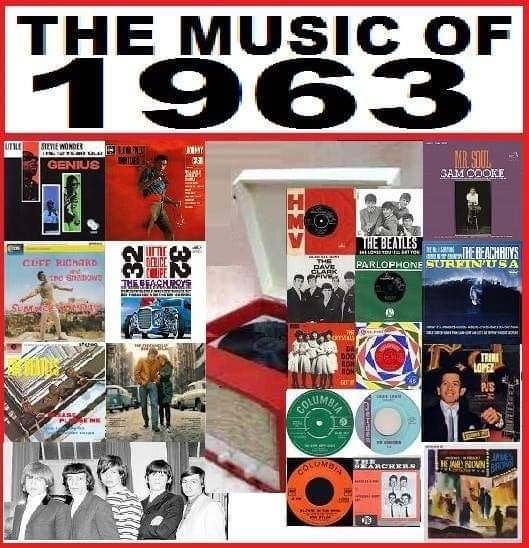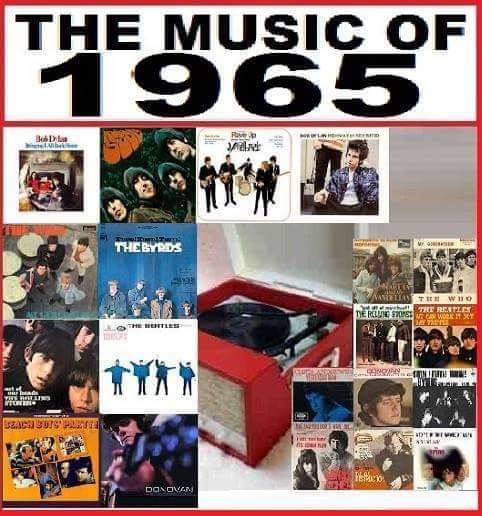
1964: 'THE BRITISH INVASION' - THE YEAR THE DIFFERENT ELEMENTS OF THE 1960s YOUTH REVOLUTION BEGAN TO COALESCE...
The 'Chronicles' year by year postings of the events of The Golden Era are periodically reposted - for the purpose of adding to them and upgrading the content. For the latest revisit (currently underway), I've decided that it's necessary to consider 1960 - 1963 as the first phase: the phase before the phenomena of The Beatles global popularity and 'The British Invasion' : two obviously connected phenomena that changed the whole youth popular social and cultural scene worldwide...
RÉSUMÉ OF 1960 - 1963
Late 1940s Beatnik intellectualising, café culture protest - with a background of Jazz music, was vying with the more recent (mid-late 1950s) high energy, scowling, 'rebels without a cause' Rock and Roll youth subculture, for dominance of the youth scene...
But during this early 1960s phase, a New Wave fringe was breaking away from the Beatnik scene in the USA: a Folky protest fringe, that looked to earlier Folk singers, like Woody Guthrie, for inspiration. Bands and artists, such as Peter Paul and Mary; Bob Dylan; Joan Baez; and Judy Collins emerged from this fringe - and recorded protest song albums that charted...
Meanwhile, in the UK, for the first time, British youth didn't just straight up "ape' American youth culture: two very British variations on American youth culture emerged:
The Teddy Boys: who were into American Rock and Roll, but ditched the jeans and leather look for sharp dressing Edwardian style suits (that's why the name 'Teddy': short for Edward.)
And, emerging from the British Beatnik scene: The Mods: a youth culture centred on London, which ditched Beatnik grungy dressing, in favour of sharp suits (inspired, so I've read, by the Teddy Boys: though not dressing the same, Edwardian suits, way: rather, a slick modern look); over which was draped a parka anorak... To further distinguish themselves as stylish youth, the Mods rode Italian style scooters, rather than Rock and Roll motorbikes...
Musically, the Mods sound ditched Beatnik Jazz for something more R'n'B / Pop - though the guitar power riffs of bands like The Who and The Kinks might be considered the template for the Heavy / Hard Rock that was to emerge towards the late 1960s...
ANOTHER VERY INFLUENTIAL SCENE - BUT IN THE BACKGROUND...
Around the same time, at venues in the western outskirts of London, a separate British youth culture development scene was quietly at work: The Ealing Club, in NW London, is widely recognised as the birthplace of British Blues: young white British guys playing the music of older generation African Americans: music that American youth - white or black - didn't play - or even get to hear much...
In the western suburb of Richmond, especially at a venue in the area called Eel Pie Island (on the Thames, between Richmond and Twickenham), a mix of culturally evolving Beatniks, Folkies, and Blues players, made a separate and very cool scene; they identified as 'Heads' and 'Freaks': constructing their own, individual, alternative 'reality' in their culture and lifestyle...
AND - 'UP NORTH'...
Liverpool - Merseyside - The Cavern Club... Young bands and artists were making music that was influenced by American Rock and Roll - but also by British stars who brought a British twist (no pun intended, considering the American Twist dance craze was big at the time... ) to American music: artists and music like like Lonnie Donegan and Skiffle; and pure Pop...
The Mersey Beat sound developed out of these influences - but it was distinct. As well as the sound, there was a 'look'; an image...
1963
In the UK, a Mersey Beat band, called The Beatles, had made a small blip on the UK charts in 1962, with the single 'Love Me Do'; but things warmed up at the beginning of 1963, with the number 2 hit, 'Please Please Me' - and then a UK Pop music phenomenon was well and truly established, when the follow-up, 'From Me To You' reached number 1...
Mersey Beat caught the attention of the UK public - and other Mersey Beat bands and artists filled the UK singles charts: perhaps most notably, Gerry And The Pacemakers: who made history by becoming the first band to score number 1 UK hits with their first three singles.
In the same year, North London produced what was called 'The Tottenham Sound' - with the band The Dave Clark Five: a big beat, stomping sound to rival Mersey Beat...
The British Pop music scene was buzzing with diverse new sounds and ideas...
EARLY 1964
I've learned from American folks who follow 'Chronicles' (a special shout out to Catherine (Baffa)), that even before The Beatles' groundbreaking appearance on 'The Ed Sullivan Show', in February 1964, which launched both Beatlemania and 'The British Invasion' in the USA, American youth had heard about what was happening in the UK music scene - but it didn't get much airplay on US TV or radio...
But in January 1964, The Beatles entered the Billboard Hot 100 mid-table - then shot up to the top 5 in a week...
US TV and radio took note - especially Ed Sullivan,but seems...
The Beatles' February 1964 performance on 'The Ed Sullivan Show' is now the stuff of legend: it opened the floodgates to British bands and artists to storm to popularity in North America and around the world - from 1964 on through the 1960s and into the 1970s...
The Beatles - and other Mersey Beat bands and artists; British Blues bands, like The Animals and The Rolling Stones; Mods, like The Who and The Kinks; Pop bands like Herman's Hermits, and Beatnik Folkies, Heads, and Freaks, who'd hung around Eel Pie Island - most notably a young Scottish born wanderer, inspired by Bob Dylan - called Donovan - became huge hits in North America in the early years of 'The British Invasion'. The centre of modern popular culture moved from the USA to the UK, and new British bands and artists continued to thrice world-wide, throughout The Golden Era...
North American youth - and the world - couldn't get enough of 'British Invasion' sounds...
THE CAUSE?
I look at things through coolly analytical eyes...
I suggest that the usual money motivated corporate Interests initially played a big part in youth Pop culture - from the 'invention of' the teenager in the 1950s, with Rock and Roll - right up to 'The British Invasion': all seen as just a lucrative market to get teens to spend their money.
After Rock and Roll - a next wave, in the early 1960s, needed something new - and significantly different...
There may also be an element of political cynicism: American youth, via the new Folky protest fringe of the Beatniks, was beginning to get restless and worried about American involvement in the Vietnam War - and about Cold War politics and aggression generally... Perhaps a major distraction was needed... Something to get this focused youth unfocused and placated by a new craze...???
Well, I can't ignore these possible cynical elements..
Mind you, that's not to take away from the attraction of the sheer talent, the creativity, the innovation, charisma that also played a big part in 'The British Invasion' phenomenon...
However, I'd certainly say that it was all just intended as pure entertainment - and commercial interests...
BUT...
THE EFFECT...?
Effects of cynical political and / or commercial plans, tend, I think, to be seen by the planners only through their own narrow lens... They broadly assume that those that they are targeting are pretty gullible - a bit naive and, frankly, a bit stupid, in fact: easily manipulated... They cannot anticipate any other consequencesn of their plans but the ones they have in mind...
It's been my suggestion in past 'Chronicles' articles, that the mixing and mingling of intellectualising Beatnik youth / and its American Folky protest fringe - with the raw, but aimless energy of Rock and Rollers - and then that missing ingredient: the organised, long time tradition of 'class war' anti-Establishment protest and resentment of working class and lower middle class British youth: more especially, a 1960s British working class that was the first to benefit from childhood onwards from the very socialist polices of the 1945 - 1951 Labour government: extensive free schooling; the National Health Service; provision for proper nutrition - produced unforeseen effects and consequences of 'The British Invasion'...
This was a robust, educated, healthy - and energised British youth - well used to the British tradition of protest against injustice and unfairness...
Mix that in with Beatnik / the emerging Beatnik intellectualising Folky fringe - and Rock and Roll energy... in an increasingly dangerous world, where the Establishment powers seemed internet on bloody and destructive wars - and on pushing and provoking each other closer and closer to the nuclear annihilation of humanity...?
Well, let me say that I don't think that the Establishment saw the results and consequences coming...
Over the next two or three years, this youth entertainment became so much more than just entertainment: the ideas, the creative genius, the motivations, the inspirations of the artists involved, produced music that was, in large part, an education: it discussed social and political issues - and informed its audience; and more than that: it created a revolution in TRULY free thinking: by discussing and informing about history, philosophy, world religions, ideologies: a search for a new view of what reality is: a better understanding of it than the accepted view - which had brought humanity to the brink of nuclear annihilation...
CONCLUSION
In short, 'The British Invasion' was the catalysing element that would bring about a coherent and cohesive youth social and cultural revolution: '...a whole generation - with a new explanation...' (Scott McKenzie, 'San Francisco' (1967))...
That's my take on the possible deeper causes and effects of the pivotal event in modern history, that we call 'The British Invasion', folks... It needed a special article: 1964 was a very important year in The Golden Era... (M).
Textual content (and graphic image (other than the Union Flag design rough copy)) © Copyright MLM Arts 20. 08. 2022. Edited and re-posted: 18. 02. 2024

1964: THE FIRST YEAR OF 'THE BRITISH INVASION' POP CULTURE PHENOMENON
February 1964 was the first month of the first year of what is recorded in history as 'The British Invasion': the sudden and massive popularity of British bands and artists in North America and around the world; a phenomenon that moved the centre of modern popular culture from the USA to the UK.
The Beatles paved the way after the band's barnstorming appearance on The Ed Sullivan Show in the USA in February 1964. After that other British bands and artists followed: most notably Mersey Beat bands - and - very significantly - British Blues bands and artists (such as The Rolling Stones, and The Animals), who took the music of older generation African American artists - the Blues: which at that point was popular only with older generation African Americans in the USA - and exported it back to its native USA: performed by young, white British artists... The result was a reinvention and rejuvenation of the Blues - and instant popularity among U.S youth.
Here's a list from a Billboard charts archive site of the best selling singles in the USA in that pivotal year. It's another fascinating and valuable historical archive document.
(I found this image on Google Images. . My acknowledgement and thanks to the Billboard charts archive site. )
Textual content:
©
Copyright MLM Arts 17. 02. 2024. Edited and re-posted: 18. 02. 2024

1964: DECEMBER 11th. : NME READERS' POLL RESULTS
Well now - what / who was winning readers' polls (well at least the prestigious New Musical Express, UK music paper poll) in the UK at the end of the year that revolutionised modern musical culture: the year of 'The British Invasion' phenomenon: the sudden and massive popularity of British bands and artists in North America and worldwide...? 🤔
This poll has the usual British music paper quirk of including British bands and artists in the ' World' categories - but having separate British only categories... 🙄
But we have to let that slide... 🙄
What do we have then:
Have a look at that 'New Group' category: The Rolling Stones - The Kinks - Manfred Mann (top 3); The Animals; The Bachelors (a very popular Irish, 'Easy Listening' trio); The Hollies... 😲
Then some bands that rode the wave for a while but faded out....
Blimey... The Rolling Stones were once a 'new group'... 😳 I saw them live in 1976 and thought they'd be packing it in soon at their age even then... LOL...! 😅
Top Instrumental Band: The Shadows (around since the Rock and Roll 1950s: a British guitar band with a Duane Eddy type sound; they also backed 'the British Elvis' - Cliff Richard: The Shadows - and Cliff - went on to become legends of British music. 😎)
But what's this? At 3 is The Joe Loss Orchestra: Joe was the superstar of British Big Band in the 1940s: Britain's answer to Glenn Miller - and I love to see him still in there in 1964 - as he was my Mum's favourite. 🙂
I notice too, that Joe Loss has a TV show in the Top TV category... 😏
Dusty Springfield is top British female singer. Brenda Lee relagated Dusty to second in the World category. 😌
Guess who won the British - and World - vocal group categories...? Guess who was second in both...? 😏
Yep - The Beatles - and The Rolling Stones... 😎
(But ah well - The Stones were, after all, a 'new group' at the time... 😏)
World Male Singer - is still dominated by the American Rock and Roll legends: Elvis Presley top - Roy Orbison second. 😎
British Male Singer - the aforementioned Cliff Richard.
Categories that I like on here are the 'Personality' categories: the mix both male and female - and the World Musical Personality also mixes singers and instrumentalists: a great idea, I think
World Musical Personality winner is Elvis.
British Vocal Personality is good ol' Cliff again. (I've mentioned about Cliff before on here: he was the original ch-ch-ch-changes Pop star: he was a British Rock and Roller who saw the writing in the wall for British Rock and Rollers when The Beatles arrived - and changed his style (he'd change and again over the decades) and survived - when other careers nosedived. 🤔)
Well, I'll leave you folks to peruse this latest historical archive document at your leisure... 🤔 😐
(I found this image online. My acknowledgment and thanks to whoever posted it / owns it (identity unknown to me), and of course to the NME. 🙂) (M).
Textual content: © Copyright MLM Arts 15. 01. 2025. Edited and re-posted: 19. 01. 2025
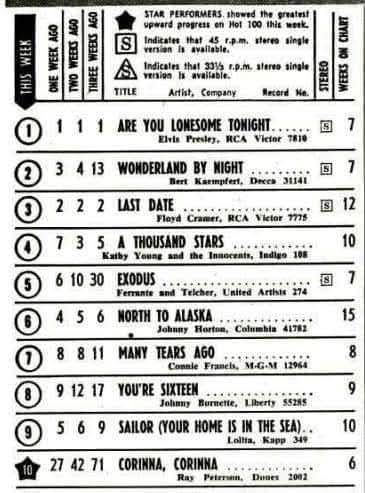
1960: END OF DECEMBER : THE U.S BILLBOARD SINGLES CHART: HOW POP MUSIC CULTURE LOOKED IN THE USA AT THE CLOSE OF THE FIRST YEAR OF THE GOLDEN ERA
1960: The USA was at that time - and had been for decades before it - the centre of youth popular culture. 1950s Rock and Roll was prominent, but the 1940s, immediately post-World War II, youth rebellion that was Jazz music, poetry spouting, philosophical chin-stroking Beatnik culture, still had a significant profile (the two youth Pop cultures didn't mix: the always somewhat aloof and 'fancied itself intellectual' Beatnik culture looked down upon this 'New Wave' of malcontent, feckless 'rebels without a cause' Rock and Roll youth).
But around this time, based in New York City's Greenwich Village, a new Folky fringe was emerging from the Beatnik scene: inspired by more down to earth poetic and musical influences, like Woody Guthrie.
THIS CHART
This chart is mostly a mystery to me... 😳
OK, I was only 2 - and in the UK at the time, but even in terms of what became lasting musical memories and classic singles, other than Elvis Presley (of course), and Bert Kampfert (I've heard of him, but I don't know his records: he appealed to the Jazz Beatniks, I think...? 🤔), and 'Exodus', by Ferrante and Teicher: the theme music from the 1960 movie 'Exodus', the rest are a complete blank to me... 🤔
But this is all part of the history of The Golden Era - and how popular culture, youth, and society developed during the 1960s and 70s - and very interesting and relevant to reflect on... 🤔
As the 1960s progressed, that Beatnik Folky fringe, and raw energetic Rock and Roll would merge with British youth 'Bolshiness' - after 1964's 'British Invasion' of British bands and artists... and the 1960s youth social and cultural revolution would begin to gell... 😎
(See: the 'Chronicles' photo albums chronicling 1960 - 1964 for more information. 🙂) (M).
(I found this picture online. My acknowledgment and thanks to whoever posted it / owns it (identity unknown to me). 🙂) (M).
Textual content © Copyright MLM Arts 03. 01. 2025. Edited and re-posted: 06. 01. 2025New paragraph
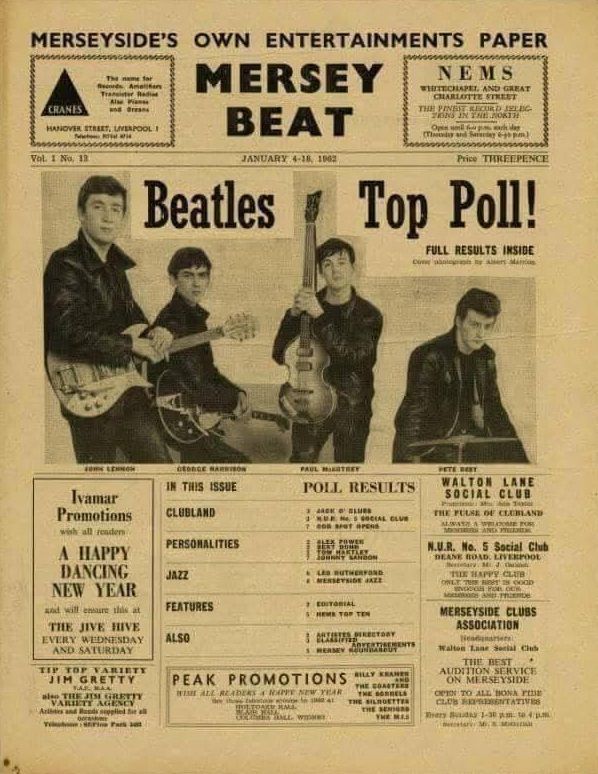
1962: MERSEY BEAT (local music paper around Merseyside, NW England) READERS' POLL: THE BEATLES VOTED TOP BAND. 😎
This is an interesting archive document that shows the developmental, formative years of British popular music culture leading up to the 1964 'British
Invasion'
phenomenon: when UK bands and artists became suddenly and massively popular in North America and worldwide.
This was 1962 - before The Beatles big breakthrough - and Pete Best was still the drummer; but the musical genre Mersey Beat was already a thriving scene in the Merseyside area of England.
(Meanwhile, in SW London, the bohemian venue Eel Pie Island (on the Thames between Twickenham and Richmond) was the place to be for British Blues and Beatnik Folky fringe music, and The Ealing Club (NW London) was the birthplace of British Blues - and the wellspring of that genre.
The 'British Invasion' phenomenon was being formulated at this time...)
(I found this image online. My acknowledgment and thanks to whoever posted it / owns it (identity unknown to me. 🙂) (M).
Textual content © copyright MLM Arts 05. 01. 2025. Edited and re-posted: 06. 01. 2025

1965: DECEMBER 10th. : NEW MUSICAL EXPRESS (NME) READERS' POLL
Well, having now completed the first 'Chronicles' review of 1975 - let's go back a decade to 1965, to see how things looked back then...
This is the New Musical Express UK music paper readers' poll of who and what was popular in musical culture each year - this one being 1965
It's a year in since the game changing 'British Invasion' of 1964 - when British bands and artists - most notably The Beatles and The Rolling Stones, but many others besides - suddenly took North America - and the world by storm, and the centre of popular modern culture shifted from the USA to the UK.
However, the poll reflects the continued popularity of late 1950s Rock and Roll bands and artists, and older generation crooners.
There's also an acknowledgment of the influential U.S Folkies - who had emerged as a fringe of the fading Beatnik scene: like Dylan, Peter, Paul, and Mary, and Joan Baez - who, as the 1960s youth social and cultural revolution developed, were to be every bit as influential in that paradigm shift in social psyche as the 'British Invasion'bands and artists...
Interesting that Beatnik Jazz artists are not well represented...
Mind you, they are included in Best Instrumental Unit - so too old style Big Band sound legend Joe Loss and his band (nothing amiss with that: Big Band music has been acknowledged on here in one of our posts dedicated to influences on Golden Era music and other culture).
But it is the British 'New Wave' that dominates this poll, as you'd expect - and with The Beatles and The Rolling Stones at the forefront.
Nice to see Donovan as best new solo singer (the category isn't called that - it's New Disc or TV Singer (Eh? What...? )); and Best New Group going to Aussie trailblazers The Seekers.
What's very noticeable is the lack of Best Singles - or Best Albums sections. Albums didn't become a big point of focus until around 1967 or so; but I'm surprised that there's no Best Singles section.
Mind you, on the plus side, there's a section that dusappeared from polls in later years when Best Singles and Best Albums sections were included: Best Disc: which, when you look at it, effectively means best track - single or album: that was a great idea...
So here's another fascinating historical archive document for us all to ponder, folks... It's Interesting to look back and see how musical culture changed and developed during The Golden Era...
(Footnote: I've blanked out Best DJ: because back then it was consistently won by someone whom it is better to blank out of history...)
(I found this image online. My acknowledgment and thanks to whoever posted it / owns it (identity unknown to me), and of course to the NME.) (M).
Textual content © Copyright MLM Arts 03. 07. 2024
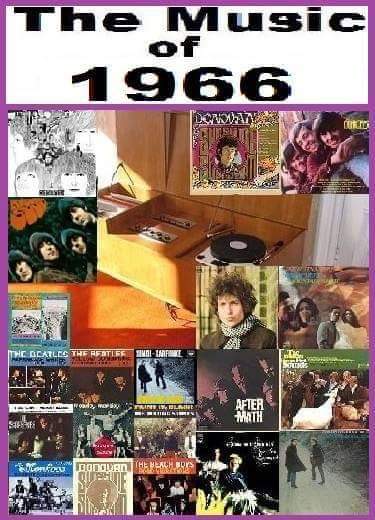
The Music of 1966
This is the year folks! - The first truly great year for the music of the era, in my opinion, and one of the greatest years of them all! It was no easy task sorting through all the great albums and singles that were released in 1966 - to come up with my personal Top 10 of both.
By 1966 there were already established artists in the new youth culture, such as The Beatles (I've included the December 1965 release 'Rubber Soul' - as it's impact was more significant through 1966), The Rolling Stones, The Beach Boys, Dylan and Donovan, and they released albums and singles that are considered to be among their finest work in their entire long careers; and also, Simon and Garfunkel, for example, established themselves in 1966, after their 1965 debut.
But there were some great debut albums too, from the Mamas and the Papas, ('If You Can Believe Your Eyes and Ears'), Frank Zappa and The Mothers of Invention ('Freak Out!'), The Monkees, ('The Monkees') Buffalo Springfield ('Buffalo Springfield'), Cream ('Fresh Cream') and others, which introduced bands and artists that would be highly significant to the development of the new music culture that was happening in the 1960s and 70s…
Yep, this was a tough year for choosing Top 10 lists..! But, as always of course, my choice is no more or less valid that anyone else’s, so do please comment on what you would include in your Top 10s…
Here are my Top 10s (In no particular order):-
Singles:
1. Yellow Submarine / Eleanor Rigby (The Beatles)
2. Paperback Writer (The Beatles)
3. Homeward Bound (Simon and Garfunkel)
4. Paint It Black (The Rolling Stones)
5. Sunshine Superman (Donovan)
6. River Deep – Mountain High (Ike and Tina Turner)
7. I'm A Believer (The Monkees)
8. Good Vibrations (The Beach Boys)
9. You Can’t Hurry Love (The Supremes)
10. Monday, Monday (The Mamas and The Papas)
Albums:
1. Rubber Soul (The Beatles)
2. Revolver (The Beatles)
3. Parsley, Sage, Rosemary and Thyme (Simon and Garfunkel)
4. Sounds of Silence (Simon and Garfunkel)
5. Aftermath (The Rolling Stones)
6. River Deep – Mountain High (Ike and Tina Turner)
7. Sunshine Superman (Donovan)
8. The Monkees (The Monkees)
9. Pet Sounds (The Beach Boys)
10. Blonde on Blonde (Bob Dylan)
What else in music in 1966..? Buffalo Springfield was formed, David Jones became David Bowie (had to, because of the arrival and massive popularity of The Monkees, with their own Davy Jones) – and John Lennon was woefully misunderstood when he told the London Evening Standard newspaper that The Beatles are now bigger than Jesus…
There was of course a great wailing and a burning of all things Beatles – especially in the American ‘Bible Belt’ – in response to Lennon's remark; I guess by the kind of shallow, knee-jerk reaction people who don’t bother to really listen and understand what is being said when their religion is mentioned – I find that to be a sign of their own insecurity, personally – but hey – let's not get all amateur Freud here… Let’s be clear – Lennon’s comment was, I think it's fairer to say, a criticism of the vacuous and shallow state of society: that a group of entertainers could attract more attention and adoration than, well - than God (if you are a believer in a theistic religion, that is…). He was NOT being disrespectful to Christianity, nor was he making an arrogant boast.
(I found the images for this collage online. My acknowledgment and thanks to the various people who made them and own them. ) (M).
Textual content:
©Copyright MLM Arts 11.10.2013 Re-posted: 01. 01. 2015; and on 26. 02. 2016. Edited and re-posted: 30. 08.2017. Edited and re-posted: 13. 12. 2019. Edited and re-posted: 27. 10. 2022
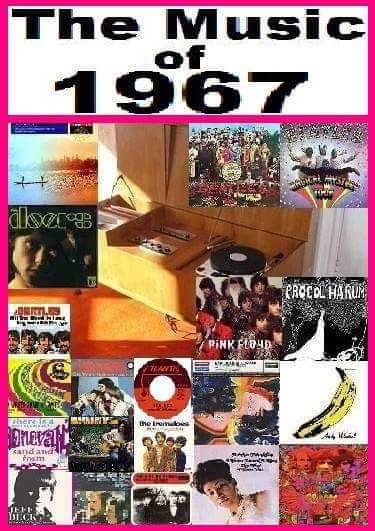
THE MUSIC OF 1967
1967 – The Summer Of Love, and the year that The Beatles did again what they had done when they ‘arrived’ in 1962: reinvented Pop / Rock music – this time with the release of the album ‘Sergeant Pepper’s Lonely Hearts Club Band’. The Hippie and Psychedelic scene was ‘out there’, and the music of that year reflected that. Indian and ‘New Age’ cultural and philosophical influences combined with experimental drug use to produce music and artwork that was often abstract and surreal.
The Beatles used Classical instruments, and also the new and still experimental mellotron on the band's 1967 albums (or E.P / album in the case of 'Magical Mystery Tour'). George Harrison experimented with sitar sounds, and lyrics based on Indian philosophy, in the track ‘Within You, Without You’ on the 'Sergeant Pepper album. The Moody Blues made similar musical experiments and innovation on the ground-breaking 'Days of Future Passed' album; and Procol Harum's song 'A Whiter Shade of Pale' was a clear homage to the Classical composer Bach, musically, and lyrically remains one of the most surrealist / abstract lyrics ever recorded...
The Beatles' ‘Magical Mystery Tour’ album and E.P was a clear indication of how innovative and ground-breaking - even to the extent of being risky, in terms of critical appraisal - 1967 was for creative musical talents of this era. It was the first serious criticism that The Beatles music ever received: they had pushed the boundaries yet again, and even the 'Beatles friendly' critics were not fully prepared for the likes of ‘I Am The Walrus’ and 'Blue Jay Way'… However, personally, ‘Blue Jay Way’ is one of my favourite George Harrison songs..!
This was also the year that The Beatles made history - yet again: this time by broadcasting the specially ‘All You Need is Love’ ‘live’ across the World, by satellite. The song was specially written for that history making satellite broadcast event.
In a great year for influential debuting bands and artists, 1967 saw debuts for The Doors; The Mamas and the Papas; The Velvet Underground; Procol Harum; Pink Floyd; and Jimi Hendrix.
Pink Floyd’s debut album: ‘Piper at the Gates of Dawn’ was named after the chapter in Kenneth Graham’s classic novel ‘The Wind in the Willows’, in which the animal characters are awe struck and enraptured at sighting the nature god Pan - playing his pipes at dawn. It was very much in tune with the spiritual / mystical search that was part of the youth cultural and social revolution. ‘Piper at the Gates of Dawn’ was their only Sid Barrett led album. Barrett’s experimenting with the drug LSD would cause him to become yet another tragic casualty of the misuse of drugs when his mental health deteriorated.
The Velvet Underground debuted with the album ‘The Velvet Underground and Nico’. The album is laced with references to drug use and other anarchic themes. The cover art was by the recognised doyen of the psychedelic underground art scene – Andy Warhol.
Jim Morrison’s lyrical genius was expressed to great effect in the album ‘The Doors’: ‘Break on Through (To the Other Side)’, and ‘The End’ being songs which were inspired by the search for alternatives to materialist ‘reality’, and in the case of Jim Morrison, I suggest, expressions of his troubled search for something beyond the corporeal.
Procol Harum released their debut album, ‘Procol Harum’. The album originally didn't ocontain the classic single 'Whiter Shade of Pale', but it was added to the album after it's huge success. It's a song which, it is said, very much impressed and influenced Jim Morrison and John Lennon, who read hallucinogenic and ‘other worldly’ influences into the surreal, abstract and enigmatic lyrics: lyrics which remain among the most debated and analysed lyrics in modern music culture…
(The music in the song is widely acknowledged to be inspired by Bach’s "Sleepers, Wake!" and "Air on the G String", but, contrary to popular belief, it does not actually straight-forwardly rip-off those pieces, but is, according to expert analysis, significantly different enough to be considered original – though, perhaps, derivative).
Jimi Hendrix released his outstanding debut album, 'Are You Experienced?', to great critical acclaim.
The Bee Gees made their first chart impact, with the album 'Bee Gees' 1st.' (which was actually not their first, but their third album release), and the single 'New York Mining Disaster, 1941'.
Soul / R ‘N’ B legend Aretha Franklin released her brilliant ‘I Never Loved a Man the Way I Love You’ album, which included the classic song ‘Respect’.
The Moody Blues reinvented themselves, and became one of the pioneers of Prog. Rock with the album: ‘Days of Future Past', an album that is widely considered to be the first ever Prog. Rock concept album.
Cream released what I, personally, would consider their best album: Disraeli Gears.
With the Indian influence on Rock music being so pronounced, I must mention a beautiful album by Indian musicians, which came out that year: ‘Call of the Valley’, by Shiv Kumar Sharma, Harirasad. Chaurasia, Brij Bushan Kabra. It’s one of the best albums of 1967.
The singles charts were equally full of quality in 1967, as I will show in my personal Top 10. (Though one or two of these may raise a few eyebrows..!)
My Top 10 albums for 1967 (no particular order):
1. Sergeant Pepper’s Lonely Hearts Club Band (The Beatles)
2. Days of Future Past (The Moody Blues)
3. I Never Loved a Man the Way I Love You (Aretha Franklin)
4. Piper at the Gates of Dawn (Pink Floyd)
5. The Velvet Underground and Nico (The Velvet Underground and Nico)
6. Procol Harum (Procol Harum)
7. Magical Mystery Tour (The Beatles)
8. The Doors (The Doors)
9. Call of the Valley (Shiv Kumar Sharma, Harirasad. Chaurasia, Brij Bushan Kabra)
10. Disraeli Gears (Cream)
My Top 10 singles for 1967 (no particular order):
1. A Whiter Shade of Pale
2. Respect (Aretha Franklin)
3. There is a Mountain (Donovan)
4. Tracks of My Tears (Smokey Robinson)
5. 59th Street Bridge Song (Feelin’ Groovy) (Simon and Garfunkel)
6. Silence is Golden (The Tremeloes)
7. All You Need is Love (The Beatles)
8. Ruby Tuesday (The Rolling Stones)
9. Hi Ho Silver Lining (Jeff Beck)
10. Daydream Believer (The Monkees)
As ever – this is just my opinion! – You are all welcome to post your own..!
(I found the images for this collage online. My acknowledgement and thanks to the various people who own these images. :))
(M).
Textual content: ©Copyright MLM Arts 29. 03. 2016. Edited and re-posted: 27. 09. 2017. Edited and re-posted: 28. 12. 2019. Edited and re-posted: 04. 01. 2023

1967: Sept. 22nd. : TIME MAGAZINE REACTS TO THE BEATLES' CHANGE OF IMAGE...
The Psychedelic phase of modern popular culture arrived full formed in 1967 - and was celebrated by what's recorded as The Summer of Love.
Like the other developments in the 1960s youth social and cultural revolution, the Psychedelic phase was not just about styles of music and fashionable image: it was part of the challenge to Establishment 'norms' - and a TRULY free thinking (as distinct from what 'free thinking' now represents: adopting a particular dogmatic ideology and dogmatically defending it... ) search for an understanding of 'Reality' that was an improvement on the Establishment purely materialistic 'Reality' that had led the world to the brink of annihilation.
That meant exploring the nature of mind - consciousness - spirituality - philosophy - and the widest range of religious and philosophical teachings; which were sometimes explored alongside the use of mind altering substances (the chemically produced LSD (promoted by Harvard University psychologist Dr. Timothy Leary: originally as part of his Harvard sponsored research into achieving positive mind altering states), and also plant based substances, used in traditional folk religion ceremonies: such as Native American peyote.
The Beatles - George being the innovator, inspired by his mentor, Ravi Shankar - again inspired the youth revolution, by going to India to seriously study Brahmanic practices of meditation and philosophy.
The image change / and deeper exploration of music and lyrical expression that resulted from The Beatles' innovative Psychedelic phase was dramatic: gone the loveable, cheeky chappie Mop Tops in smart suits; in - the weirdie longhairs in exotic, colourful, casual clothing.
Some of the original, Pop group 'boy band' fans of The Beatles found it 'all too much' - and turned to The Monkees or Motown - or something else more easily digested.
By the look of this Time front page - a kinda Picasso-esque distortion of The Beatles - it suggests that Time wasn't at all sure what to make of this very different 'new incarnation' of the previously easy enough to get a handle on Beatles.
(In fairness though: I haven't read the associated article - it might be very complimentary for all I know...? )
But this was the 1960s social and cultural revolution: by 1967 mainstream society was only just beginning to realise that this was MAYBE not just another teenage phase or fad... Though it still wasn't fully realised that this was a revolution in popular culture that would shape society in the future: affecting culture, education, social attitudes - and politics...
This is another interesting historical archive document that is very relevant to the recording of this history and how it unfolded...
(I found this image online. My acknowledgment and thanks to whoever posted it/ owns it (identity unknown to me) - and of course to Time magazine. ) (M).
Textual content © Copyright MLM Arts 25. 09. 2024. Edited and re-posted: 26. 09. 2024

THE MUSIC OF 1968
THE DEVELOPMENT OF THE 1960s YOUTH SOCIAL AND CUTURAL REVOLUTION
1966 prepared the way for the take-off of what had become the cohesive, unified ideology of the various expressions of youth social and cultural revolution and protest, which came to be referred to collectively (though inaccurately) by the catch-all term ‘Hippie’; 1967 launched it full-on with ‘The Summer of Love’ – and 1968 saw Rock and Pop music fully embrace the themes and ideologies of love, peace and harmony – and the Indian philosophical and cultural influences that played such a major part in informing Hippie and other alternative lifestyles and the youth revolution’s vision for the future of humanity.
THE - GENUINELY - FREE THINKING SEARCH FOR ANSWERS...
Hindu, Buddhist, and ‘New Age’ spiritualist core beliefs, practices and doctrines were featured in significant album and singles releases, such as Procol Harum’s ‘Shine On Brightly’ album, with its epic ‘In Held Twas in I’ suite, including ‘Glimpses of Nirvana’ (etc.); The Moody Blues album ‘In Search of the Lost Chord’ (Aum); The Small Faces album ‘Ogden’s Nut Gone Flake’, with its surrealist, meditative musing in the suite ‘Happiness Stan’; Tyrannosaurus Rex's debut album ‘My People Were Fair’, featuring (what I think is) the first ‘Hari Krishna’ chant on a Western Folk/ Rock/ Pop song: ‘My Inca Love’; The Rock musical ‘Hair’ which was a celebration of the hippie spiritual belief in the dawning of a new astrological age (Aquarius), which was to be an age when love, peace and harmony would replace the 'age' and powers of conflict that ruled the Earth at the time.
CHANGE AND REACTION TO CHANGE
1968 was a powerful year of change and reaction to change. In the midst of this gathering momentum of peace and rejection of conflict, negative forces backlashed in response in ways that were devastatingly destructive. It seemed like the rise of positive energy in the world caused the established negative forces in the world to react in the only way that they knew: with violence and aggression. (Call this spiritual – or call it Einstein’s ‘Cause and Effect’ - either way, 1968 seemed to demonstrate this phenomenon…) Bad things happened in 1968… How did the modern culture of Love, Peace and good vibes respond…??? – Woodstock in 1969: we SHALL overcome…
(But that’s for the ‘Chronicle of 1969’…)
For now, here’s my list of Top 10 albums and singles for 1968 (no particular order):
Albums:
1. The White Album (The Beatles)
2. Ogden’s Nut Gone Flake (The Small Faces)
3. In Gadda Da Vida (Iron Butterfly)
4. The Sounds of India (Ravi Shankar)
5. In Search of the Lost Chord (The Moody Blues)
6. My People Were Fair And Had Sky In Their Hair, But Now They’re Content To Wear Stars On Their Brows (Tyrannosaurus Rex)
7. The Hurdy Gurdy Man (Donovan)
8. Hair (the Musical) (Lyrics by James Rado and Gerome Ragni and music by Galt MacDermot)
9.. Electric Ladyland (Jimi Hendrix)
10. Shine On Brightly (Procol Harum)
Singles:
1. Sunshine of Your Love Cream (Cream)
2. Son of a Preacher Man (Dusty Springfield)
3. Hey Jude (The Beatles)
4. Lazy Sunday (The Small Faces)
5. Lady Madonna (The Beatles)
6. Do It Again (The Beach Boys)
7. Born To Be Wild (Steppenwolf)
8. Street Fighting Man (The Rolling Stones)
9. On the Road Again (Canned Heat)
10. All Along The Watchtower (Bob Dylan)
Just my person choice – and, of course, it’s not any better or worse a choice than anyone else’s – so feel free to add your own!
(I found the images for this collage online. My acknowledgement and thanks to the various people who own these images. :))
(M).
Textual content:
©Copyright MLM Arts 20. 12. 2013.
Edited and re-posted: 25. 04. 2016. Edited and re-posted: 30. 10. 2017. Edited and re-posted: 12. 01. 2020. Edited and re-posted: 02. 01. 2023. Edited: 07. 01. 2023
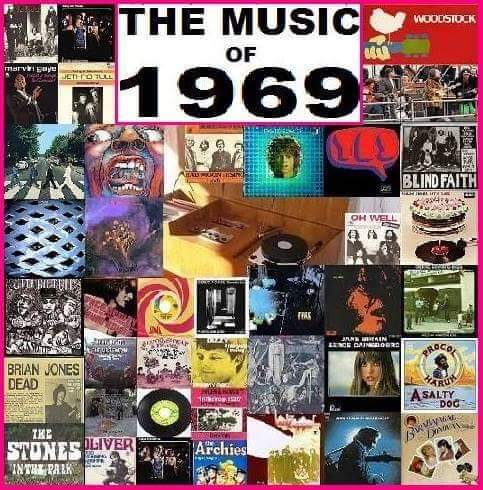
THE MUSIC OF 1969
What a massive and inspirational year in music to end the first decade of the youth cultural and social revolution; the forming of modern culture; the paradigm shift – that was the 1960s… 😎
Consequently, this is a necessarily long posting, but I hope that you will all find it quite interesting and entertaining. I’m happy to say that this was a combined effort, written by my late, great buddy Big D; who wrote his sections of this only several weeks before he passed away, and me. That means that Big D contributed to all 10 years of this first phase of this project: the 1960s. I’m very glad about that… 🤗
Big D’s account (with edit. By (M)).
1969 for me was a pivotal time as far as music was concerned. The [early 60s] Ferry Cross the Mersey with the Liverpool sound of the Fab Four and the likes had [by the mid 1960s] been put into dry dock. 1969 gave us a new form of transport, as David Bowie blasted us off into space with the stellar hit Space Oddity. Music [which had been evolving throughout the 1960s] was getting a major makeover in more ways than one. Out went the [early 60s] mop top hairstyles and suits in favour of unkempt long hair, cheesecloth shirts, dessert boots and denims, the uniform of The Love Generation. So we cannot mention 1969, without mentioning Woodstock. Billed as an Aquarian Exposition: 3 Days of Peace & Music, it was the mother of all concerts. The defining event of the ‘hippie generation’ [‘hippie’ being a convenient ‘catch-all’ term for the various expressions of mid – late 1960s youth culture: Hippies; Heads; Freaks; Children of God; Flower Children etc.]. Here are some statistics from the event.
WOODSTOCK STATS:
Ticket price: $18 in advance, $24 at gate; Tickets sold in advance: about 100,000; Tickets sold at gate: 0; When festival was declared free: noon Aug. 15; Cost of festival: $2.4 million; Total paid to all talent: $180,000; Highest-paid performer: Jimi Hendrix, $32,000; Years it took for promoters to break even: 11; Musical performances: 32; Space at Max Yasgur's farm: 600 acres; Rent Yasgur charged: $75,000; Crowd estimate: 500,000 [Richie Havens is on record as insisting that the crowd totalled around 800, 000 at its most numerous]; Medical cases treated: 5,163
THE GIG:
The initial estimate of 200,000, which was already an unprecedented and incredible number, turned out to be at least 400,000 [up to 800,000], were treated to an amazing array of stars and varied musical styles, whom I am sure we are all familiar with. Personally my highlights were Ritchie Havens (who could forget "Freedom") Janis "Pearl" Joplin and Jimi Hendrix, his rendition of the Star Spangled Banner still gives me goose bumps.
[My Woodstock highlights are: Country Joe and The Fish rousted things up with the in-your-face and tell it as it is anti-war anthem ‘Feels Like I’m Fixin’ To Die Rag’. The Who’s performance was a spectacular, and I pick out ‘See Me, Feel Me’ and ‘I’m Free’ from their 1969 album ‘Tommy’ as highlights. I also love Joan Baez’s very moving and emotionally sincere set, especially ‘Joe Hill’ and ‘Drug Store Truck Driving Man’. Joe Cocker was one of the show stealers as he gave the definitive performance of ‘With A Little Help From My Friends’ as part of his set].
For the entire list the artists that played Woodstock and every song that they performed, cut and paste this link to the excellent page Digital Dream Door: Woodstock 1969 Lineup and Songlist | DigitalDreamDoor.com
THE ROOTS OF MUSIC’S DIRECTION FOR THE 1970s:
But now the petals from the "Flower Power Generation" [of Hippies, Heads, Freaks, Flower Children, Children of God etc.], that had emerged in the mid-1960s out of the Beatniks, Rockers, Mersey Beat and Mods of the early 1960s, which were gently blowin' in the wind, were now being blown at gale force by a new wave of music: "ROCK" - as Led Zeppelin exploded on to the music scene with their eponymous first album: Led Zeppelin, and, along with Cream, took on the mantle of Rock super-group.
[The Zeppelin sound on their first album was very Bluesy, but it was their second album, Led Zeppelin II (also 1969), that really began to identify the band as something new and innovative. There was still the Blues influence, with tracks such as ‘The Lemon Song’, but Heavy Rock explodes out of the classic riff ‘Whole Lotta Love’ (controversially adapted from a Willie Dixon Blues song). ‘Livin’, Lovin’ Maid' is also a Heavy mover. There are hints too of the subtler side of Zeppelin, to be revealed in full on 1970s ‘Led Zeppelin III’, with ‘Thank You’ and Ramble On’].
In 1969 The Beatles were about to disband and abdicate their position as top band in modern music culture – and Led Zeppelin had arrived to take up that mantle…
1969 for me [Big D] personally, is when my music world really changed. It saw the formation of Deep Purple MKII. Here is my list of Top 10 singles and album choices from that great year - in no particular order.
D: )
Top 10 Singles
1- Good Morning Starshine, Oliver
2- You've Made Me So Very Happy, Blood, Sweat and Tears
3- Honky Tonk Women, The Rolling Stones
4- Aquarius / Let The Sunshine In, The Fifth Dimension
5- Dizzy, Tommy Roe
6- Ruby, Don't Take Your Love to Town, Kenny Rogers and The First Edition
7- Sugar Sugar, The Archies
8- In the Year 2525, Zager and Evans
9- Space Oddity, David Bowie
10- Hallelujah, Deep Purple
Albums
1- Led Zeppelin II, Led Zeppelin
2- Live At San Quentin, Johnny Cash
3- Deep Purple, Deep Purple
4- Space Oddity, David Bowie
5- Tons Of Sobs, Free
6- On The Threshold Of A Dream, The Moody Blues
7- Jane Birkin/Serge Gainsbourg, Jane Birkin & Serge Gainsbourg
8- Yes, Yes
9- Taste, Taste
10- In The Court Of The Crimson King, King Crimson
P. S. For all guitarists. Fender have released a signature model of the Black Strat used by Ritchie [at this time]. The tremolo arm on [that] guitar was later replaced by a quarter inch bar, because Ritchie kept breaking them. The signature Strat comes complete with the thicker bar. Happy guitaring.
D: )
(M): Top 10 Singles (no particular order):
1. In The Year 2525 (Zager and Evans)
2. Get Back: (The Beatles)
3. I Heard It Through The Grapevine: (Marvin Gaye)
4. Honky Tonk Woman (The Rolling Stones)
5. Sugar Sugar (The Archies)
6. Bad Moon Rising (Creedence Clearwater Revival)
7. The Israelites (Desmond Dekker)
8. Oh Well (Fleetwood Mac)
9. Give Peace A Chance (Plastic Ono Band)
10. Living In The Past (Jethro Tull)
Top 10 Albums:
1. Led Zeppelin II (Led Zeppelin)
2. In The Court Of The Crimson King (King Crimson)
3. Abbey Road (The Beatles)
4. Let It Bleed (The Rolling Stones)
5. Tommy (The Who)
6. Willy And The Poor Boys (Creedence Clearwater Revival)
7. Stand Up (Jethro Tull)
8. A Salty Dog (Procol Harum)
9. Barabajagal (Donovan)
10. YES (YES)
This was such an incredible year for record releases. It’s good that this posting features two lists of Top10s - and with only a few agreements in them. I’m sure everyone on this page will have very different lists of your own – all as valid as these…
WHAT ELSE IN MUSIC IN 1969..?
Blind Faith played to 100,000 people at London’s Hyde Park and The Beatles played their last ever gig: the famous free show on the roof of the Apple offices in London.
Tragically it was the year that Brian Jones of The Rolling Stones died (R.I.P)
The Rolling Stones survived that tragic loss, and paid tribute to their founder member guitarist by releasing doves at their free concert at London’s Hyde Park in 1969. At that gig Mick Taylor made his live debut as The Stones new guitarist.
What a year for music: Prog. Rock was now an established genre that would push experimentation and innovation for the next several years; Heavy Rock was now out there and would go on to develop and diversify its sound with Black Sabbath, Deep Purple, Uriah Heep, Kiss, Iggy and the Stooges, Bachman Turner Overdrive and many others (including the early - mid 70s Glam Rock variation); Art Rock was the natural successor to Psychedelic Rock and was still developing, with Bowie; The Move – and the newly arrived Genesis (who would soon evolve into a Prog Rock band), and songs from the grand celebration of Art / Psychedelic Rock - the musical ‘Hair’- charted as singles…
The 1960s ended in triumph: both for the achievements of the social and cultural revolution and its campaign for peace, love, fairness, justice and equality, and also for the advances in cultural, especially musical, innovation. The 1970s was set-up to be an exciting time for modern music and all other culture…
(I found the images for this collage online. My acknowledgment and thanks to the various people who made them (identity unknown to me). ) (M).
(M).
Textual content:
©Copyright MLM Arts (with acknowledgement to content by Big D) 08. 03. 2015. Edited and re-posted: 01. 06. 2016. Edited and re-posted: 30. 11. 2017. Edited and re-posted: 04. 01. Edited and re-posted: 2019. 28. 01. 2020Edited and re-posted: 04. 01. 2023

A CELEBRATION OF THE 50th. ANNIVERSARY OF THE WOODSTOCK FESTIVAL (August 15th., 16th., 17th., 1969)
The Woodstock Festival (1969). Truly a phenomenon. I'd say it is the centrepiece of the era; it's like the very essence of the 60s, and the 70s that lay ahead, was condensed into this event: three Summer days of celebrating Peace, Love and Music.
Big D’s account (with edit. By (M)).
1969 for me was a pivotal time as far as music was concerned. The [early 60s] Ferry Cross the Mersey with the Liverpool sound of the Fab Four and the likes had [by the mid 1960s] been put into dry dock. 1969 gave us a new form of transport, as David Bowie blasted us off into space with the stellar hit Space Oddity. Music [which had been evolving throughout the 1960s] was getting a major makeover in more ways than one. Out went the [early 60s] mop top hairstyles and suits in favour of unkempt long hair, cheesecloth shirts, dessert boots and denims, the uniform of The Love Generation. So we cannot mention 1969, without mentioning Woodstock. Billed as an Aquarian Exposition: 3 Days of Peace & Music, it was the mother of all concerts. The defining event of the ‘hippie generation’ [‘hippie’ being a convenient ‘catch-all’ term for the various expressions of mid – late 1960s youth culture: Hippies; Heads; Freaks; Children of God; Flower Children etc.]. Here are some statistics from the event.
WOODSTOCK STATS:
Ticket price: $18 in advance, $24 at gate; Tickets sold in advance: about 100,000; Tickets sold at gate: 0; When festival was declared free: noon Aug. 15; Cost of festival: $2.4 million; Total paid to all talent: $180,000; Highest-paid performer: Jimi Hendrix, $32,000; Years it took for promoters to break even: 11; Musical performances: 32; Space at Max Yasgur's farm: 600 acres; Rent Yasgur charged: $75,000; Crowd estimate: 500,000 [Richie Havens is on record as insisting that the crowd totalled around 800, 000 at its most numerous]; Medical cases treated: 5,163
THE GIG:
The initial estimate of 200,000, which was already an unprecedented and incredible number, turned out to be at least 400,000 [up to 800,000], were treated to an amazing array of stars and varied musical styles, whom I am sure we are all familiar with. Personally my highlights were Ritchie Havens (who could forget "Freedom") Janis "Pearl" Joplin and Jimi Hendrix, his rendition of the Star Spangled Banner still gives me goose bumps.
[My Woodstock highlights are: Country Joe and The Fish rousted things up with the in-your-face and tell it as it is anti-war anthem ‘Feels Like I’m Fixin’ To Die Rag’. The Who’s performance was a spectacular, and I pick out ‘See Me, Feel Me’ and ‘I’m Free’ from their 1969 album ‘Tommy’ as highlights. I also love Joan Baez’s very moving and emotionally sincere set, especially ‘Joe Hill’ and ‘Drug Store Truck Driving Man’. Joe Cocker was one of the show stealers as he gave the definitive performance of ‘With A Little Help From My Friends’ as part of his set].
For the entire list the artists that played Woodstock and every song that they performed, cut and paste this link to the excellent page Digital Dream Door: Woodstock 1969 Lineup and Songlist | DigitalDreamDoor.com
Here's to the memory if one if the greatest cultural events in history: the magnificent Woodstock Festival of 1969...
(M) - with archive material from Big D
(I found this graphic on Google Images. I don't know who it's by, but my acknowledgement and thanks to that talented artist. (M)).
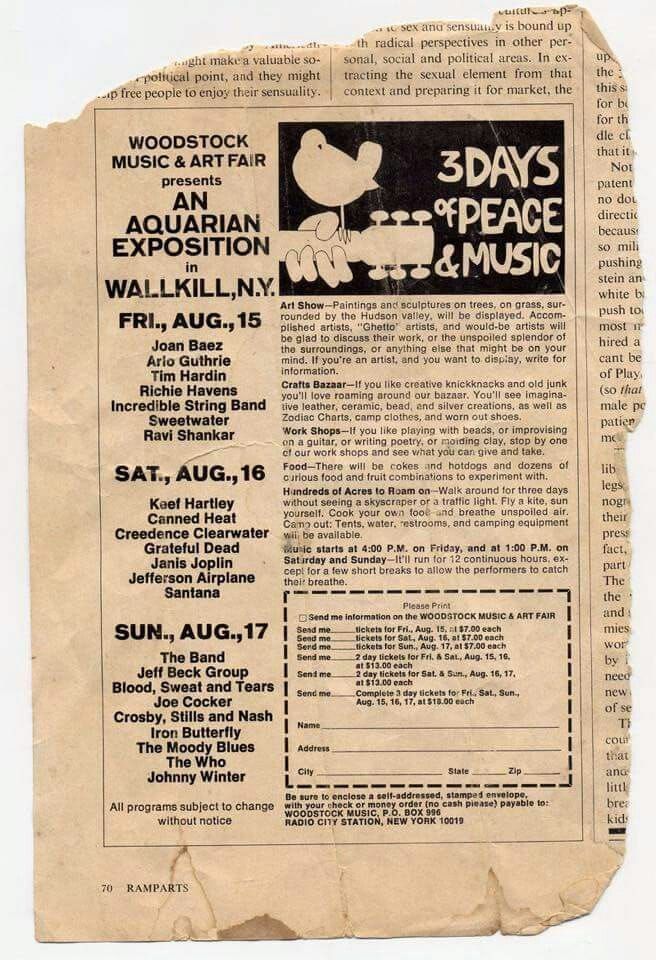
1969: AN ADVERT FOR THE MUSIC AND WOODSTOCK ARTS FESTIVAL...
Interesting document, this: it gives a pretty full overview description of the event scheduled for Max Yasgur's farm at Woodstock, New York State...
(From what I can tell, it's from a publication called 'Ramparts'... )
It's remembered as a music festival, but it was so much more than that - there were many arts and crafts stalls and events to entertain the crowds...
And I love the 'Hundreds of acres to roam' attractive selling point: away from the stress and strife of city life...
But dear oh dear...! What about those prices... $7.00 for each of the days - $13.00 for two days - $18.00 for the whole three days...? Extortionate...! LOL...!
(I am, of course, being ironic... )
This is another fascinating archive document from back in the day... )
(I found this picture online, my acknowledgement and thanks to whoever posted it (identity unknown to me)... ) (M).
THIS IS LINK TO THE 'CHRONICLES FACEBBOK PAGER POSTING OF THE ABOVE ADVERT FOR WOODSTOCK. THE LONG THREAD ATTACHED TO IT IS A GOLDMINE OF FIRST HAND ACCOUNTS OF THAT EVENT AND HOW IT AFFECTED PEOPLE.
https://www.facebook.com/121782527911692/photos/a.4204022036354367/5824459920977229/
